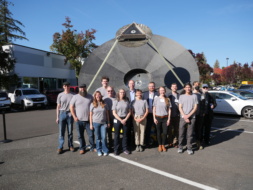DARPA, the Pentagon’s high-risk, high-reward R&D arm, has its mind on laser links. The agency is specifically working to develop an interconnected network of links for speedy and secure communications between military, civilian, and commercial space assets.
The DARPA program, known as the Space-Based Adaptive Communications Node (Space-BACN), recently announced 11 Phase 1 awardees.
Space-BACN: The Phase 1 Space-BACN awards fall into three technical areas:
- Developing a flexible, low-cost optical aperture that meets DARPA’s technical requirements. Mynaric, MBRYONICS, and CACI, Inc. received this award.
- Developing a reconfigurable optical modem that can support 100 Gbps on one wavelength. II-VI Aerospace and Defense, Arizona State University, and Intel Federal, LLC won this award.
- Identifying the command and control elements that will enable Space-BACN to talk with commercial satellite operators and other constellations. SpaceX, Telesat, SpaceLink, Viasat, and Amazon’s Kuiper received this award.
This morning, SpaceLink, an awardee from the third category, shared a bit of extra color on its role in the program.The McLean, VA-based company is working on a constellation of four MEO optical (aka laser) data relay satellites that will be able to facilitate faster communication with LEO satellites.
“We’ve been living in a dial-up world,” SpaceLink CEO Dave Bettinger told Payload. “We’re at the base of a huge adoption curve.”
SpaceLink’s planned constellation is designed so that it can connect with any satellite in LEO and downlink directly to a ground station. Laser comms are also more secure, since they use a much narrower beam than radio communications and are more difficult to intercept.
- This is a “natural defense against adversaries being able to jam or listen in” on your signals, Bettinger said.
- Today, the time between the moment when an operator recognizes they need data and the time it gets to them can be hours, or even days. “With our system, we can bring that down to minutes,” SpaceLink chief strategy and commercial officer Tony Colucci told Payload.
SpaceLink’s system is compatible with the optical comms systems being built by both DARPA and the SDA, aligning the technology with government and military needs.
The upshot: Optical communications are having a moment, as multiple government programs as well as commercial space companies look to increase communication speed and security from orbit.




